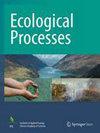Elemental evolution characteristics and influencing factors of green infrastructure network in karst mountain cities: a case study of Qianzhong urban agglomeration in Southwest China
IF 3.9
2区 环境科学与生态学
Q1 ECOLOGY
引用次数: 0
Abstract
The urban green infrastructure (GI) network is an important conduit for ecological flows and plays a crucial role in improving regional habitats, especially in karst areas that are highly ecologically fragile and sensitive. However, the existing research only focuses on the construction of GI network in karst mountain cities, and the evolution characteristics of its elements and driving mechanism are not clear, which is of great significance for guiding urban land use planning and comprehensively improving the quality of the ecological environment. In view of this, this study took Qianzhong urban agglomeration as the study area, based on multi-source data, and identified ecological sources through ecological resilience analysis. Considering the special geographic environment, the rock exposure rate factor was added to correct the resistance surface, and the minimum cumulative resistance (MCR) and gravity model were coupled to extract the GI network. The complex network topology characterization parameter was introduced to assess the spatial and temporal variations of ecological sources and corridors. Finally, the geographical detector was used to identify the dominant influencing factors and interactions of the spatial distribution of the GI network. The results showed that from 2000 to 2020, the condition of GI network elements in the study area presented a decreasing and then an increasing trend. The ecological sources or corridors in highly urbanized areas were critical for ecological flow transport and the overall structural stability of the GI network. The influence of natural factors on the spatial distribution of the GI network gradually weakened, and the influence of human factors continuously increased. The spatial distribution of the GI network was influenced by multiple factors, and the interaction between all the factors was enhanced, which gradually changed from the interaction of natural factors to the interaction of human factors during the study period. The research results will provide scientific references for the construction of an ecologically safe environment and sustainable development of karst mountain cities.喀斯特山地城市绿色基础设施网络的要素演化特征及影响因素:西南地区黔中城市群案例研究
城市绿色基础设施(GI)网络是生态流动的重要通道,在改善区域人居环境方面发挥着至关重要的作用,尤其是在生态环境极为脆弱和敏感的岩溶地区。然而,现有研究仅关注岩溶山地城市 GI 网络的构建,其要素演化特征和驱动机制尚不明确,这对于指导城市土地利用规划、全面改善生态环境质量具有重要意义。有鉴于此,本研究以黔中城市群为研究区域,以多源数据为基础,通过生态恢复力分析确定生态源。考虑到特殊的地理环境,加入岩石裸露率因子对阻力面进行修正,并将最小累积阻力(MCR)与重力模型耦合,提取出地表径流网络。引入了复杂网络拓扑特征参数,以评估生态源和走廊的时空变化。最后,利用地理探测器确定了地理信息网络空间分布的主要影响因素和相互作用。结果表明,从 2000 年到 2020 年,研究区域内的地理信息网络要素状况呈现先下降后上升的趋势。高度城市化地区的生态源或廊道对生态流的传输和 GI 网络整体结构的稳定性至关重要。自然因素对 GI 网络空间分布的影响逐渐减弱,人为因素的影响不断增强。研究期间,地表径流网络的空间分布受到多种因素的影响,各因素之间的相互作用增强,由自然因素的相互作用逐渐转变为人为因素的相互作用。研究成果将为喀斯特山地城市生态安全环境建设和可持续发展提供科学参考。
本文章由计算机程序翻译,如有差异,请以英文原文为准。
求助全文
约1分钟内获得全文
求助全文
来源期刊

Ecological Processes
Environmental Science-Ecological Modeling
CiteScore
8.50
自引率
4.20%
发文量
64
审稿时长
13 weeks
期刊介绍:
Ecological Processes is an international, peer-reviewed, open access journal devoted to quality publications in ecological studies with a focus on the underlying processes responsible for the dynamics and functions of ecological systems at multiple spatial and temporal scales. The journal welcomes manuscripts on techniques, approaches, concepts, models, reviews, syntheses, short communications and applied research for advancing our knowledge and capability toward sustainability of ecosystems and the environment. Integrations of ecological and socio-economic processes are strongly encouraged.
 求助内容:
求助内容: 应助结果提醒方式:
应助结果提醒方式:


